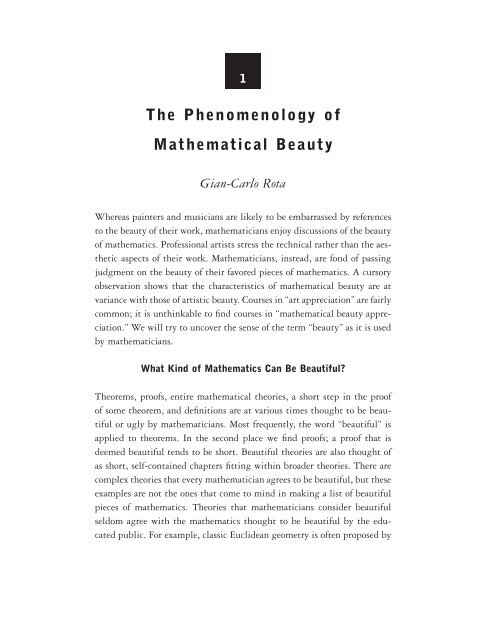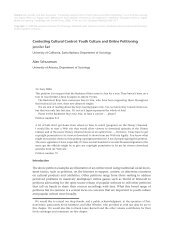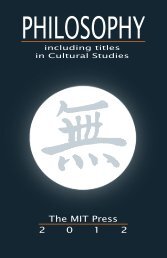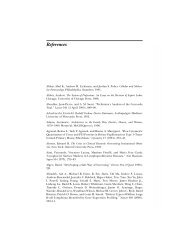The Phenomenology of Mathematical Beauty - MIT
The Phenomenology of Mathematical Beauty - MIT
The Phenomenology of Mathematical Beauty - MIT
You also want an ePaper? Increase the reach of your titles
YUMPU automatically turns print PDFs into web optimized ePapers that Google loves.
1<br />
<strong>The</strong> <strong>Phenomenology</strong> <strong>of</strong><br />
<strong>Mathematical</strong> <strong>Beauty</strong><br />
Gian-Carlo Rota<br />
Whereas painters and musicians are likely to be embarrassed by references<br />
to the beauty <strong>of</strong> their work, mathematicians enjoy discussions <strong>of</strong> the beauty<br />
<strong>of</strong> mathematics. Pr<strong>of</strong>essional artists stress the technical rather than the aesthetic<br />
aspects <strong>of</strong> their work. Mathematicians, instead, are fond <strong>of</strong> passing<br />
judgment on the beauty <strong>of</strong> their favored pieces <strong>of</strong> mathematics. A cursory<br />
observation shows that the characteristics <strong>of</strong> mathematical beauty are at<br />
variance with those <strong>of</strong> artistic beauty. Courses in “art appreciation” are fairly<br />
common; it is unthinkable to find courses in “mathematical beauty appreciation.”<br />
We will try to uncover the sense <strong>of</strong> the term “beauty” as it is used<br />
by mathematicians.<br />
What Kind <strong>of</strong> Mathematics Can Be Beautiful?<br />
<strong>The</strong>orems, pro<strong>of</strong>s, entire mathematical theories, a short step in the pro<strong>of</strong><br />
<strong>of</strong> some theorem, and definitions are at various times thought to be beautiful<br />
or ugly by mathematicians. Most frequently, the word “beautiful” is<br />
applied to theorems. In the second place we find pro<strong>of</strong>s; a pro<strong>of</strong> that is<br />
deemed beautiful tends to be short. Beautiful theories are also thought <strong>of</strong><br />
as short, self-contained chapters fitting within broader theories. <strong>The</strong>re are<br />
complex theories that every mathematician agrees to be beautiful, but these<br />
examples are not the ones that come to mind in making a list <strong>of</strong> beautiful<br />
pieces <strong>of</strong> mathematics. <strong>The</strong>ories that mathematicians consider beautiful<br />
seldom agree with the mathematics thought to be beautiful by the educated<br />
public. For example, classic Euclidean geometry is <strong>of</strong>ten proposed by
non-mathematicians as a paradigm <strong>of</strong> a beautiful mathematical theory, but<br />
I have not heard it classified as such by pr<strong>of</strong>essional mathematicians.<br />
It is not uncommon for a definition to seem beautiful, especially when<br />
it is new. However, mathematicians are reluctant to admit the beauty <strong>of</strong> a<br />
definition. It would be interesting to investigate the reasons for this reluctance.<br />
Even when not explicitly acknowledged as such, beautiful definitions<br />
give themselves away by the success they meet. A peculiarity <strong>of</strong><br />
twentieth-century mathematics is the appearance <strong>of</strong> theories where the definitions<br />
far exceed the theorems in beauty.<br />
<strong>The</strong> most common instance <strong>of</strong> beauty in mathematics is a brilliant step<br />
in an otherwise undistinguished pro<strong>of</strong>. Every budding mathematician<br />
quickly becomes familiar with this kind <strong>of</strong> mathematical beauty.<br />
<strong>The</strong>se instances <strong>of</strong> mathematical beauty are <strong>of</strong>ten independent <strong>of</strong> one<br />
another. A beautiful theorem may not be blessed with an equally beautiful<br />
pro<strong>of</strong>; beautiful theorems with ugly pro<strong>of</strong>s frequently occur. When a<br />
beautiful theorem is missing a beautiful pro<strong>of</strong>, attempts are made by mathematicians<br />
to provide new pro<strong>of</strong>s that will match the beauty <strong>of</strong> the<br />
theorem, with varying success. It is, however, impossible to find beautiful<br />
pro<strong>of</strong>s <strong>of</strong> theorems that are not beautiful.<br />
Examples<br />
<strong>The</strong> theorem stating that in three dimensions there are only five regular<br />
solids (the Platonic solids) is generally considered to be beautiful. None <strong>of</strong><br />
the pro<strong>of</strong>s <strong>of</strong> this theorem, however—at least none <strong>of</strong> those known to me—<br />
can be said to be beautiful. Similarly, the prime number theorem is a beautiful<br />
result regarding the distribution <strong>of</strong> primes, but none <strong>of</strong> its pro<strong>of</strong>s can<br />
be said to be particularly beautiful.<br />
Hardy’s opinion that much <strong>of</strong> the beauty <strong>of</strong> a mathematical statement<br />
or <strong>of</strong> a mathematical pro<strong>of</strong> depends on the element <strong>of</strong> surprise is, in my<br />
opinion, mistaken. 1 True, the beauty <strong>of</strong> a piece <strong>of</strong> mathematics is <strong>of</strong>ten<br />
perceived with a feeling <strong>of</strong> pleasant surprise; nonetheless, one can find<br />
instances <strong>of</strong> surprising results that no one has ever thought <strong>of</strong> classifying<br />
as beautiful. Morley’s theorem, stating that the adjacent trisectors <strong>of</strong><br />
an arbitrary triangle meet in an equilateral triangle, is unquestionably<br />
surprising, but neither the statement nor any <strong>of</strong> the pro<strong>of</strong>s are beautiful,<br />
despite repeated attempts to provide streamlined pro<strong>of</strong>s. A great many<br />
Gian-Carlo Rota<br />
4
theorems <strong>of</strong> mathematics, when first published, appear to be surprising;<br />
some twenty years ago the pro<strong>of</strong> <strong>of</strong> the existence <strong>of</strong> nonequivalent differentiable<br />
structures on spheres <strong>of</strong> high dimension was thought to be surprising,<br />
but it did not occur to anyone to call such a fact beautiful, then<br />
or now.<br />
Instances <strong>of</strong> theorems that are both beautiful and surprising abound.<br />
Often such surprise results from a pro<strong>of</strong> that borrows ideas from another<br />
branch <strong>of</strong> mathematics. An example is the pro<strong>of</strong> <strong>of</strong> the Weierstrass approximation<br />
theorem that uses the law <strong>of</strong> large numbers <strong>of</strong> probability.<br />
An example <strong>of</strong> mathematical beauty upon which all mathematicians<br />
agree is Picard’s theorem, asserting that an entire function <strong>of</strong> a complex<br />
variable takes all values with at most one exception. <strong>The</strong> limpid statement<br />
<strong>of</strong> this theorem is matched by the beauty <strong>of</strong> the five-line pro<strong>of</strong> provided<br />
by Picard.<br />
Axiom systems can be beautiful. Church’s axiomatization <strong>of</strong> the prepositional<br />
calculus, which is a simplified version <strong>of</strong> the one previously given<br />
by Russell and Whitehead in Principia Mathematica, is quite beautiful.<br />
Certain re-elaborations <strong>of</strong> the axioms <strong>of</strong> Euclidean geometry that issue from<br />
Hilbert’s Foundations <strong>of</strong> Geometry are beautiful (for example, Coxeter’s). 2<br />
Hilbert’s original axioms were clumsy and heavy-handed and required<br />
streamlining; this was done by several mathematicians <strong>of</strong> the last<br />
hundred years.<br />
<strong>The</strong> axiomatization <strong>of</strong> the notion <strong>of</strong> category, discovered by Eilenberg<br />
and Mac Lane in the forties, is an example <strong>of</strong> beauty in a definition, though<br />
a controversial one. It has given rise to a new field, category theory, which<br />
is rich in beautiful and insightful definitions and poor in elegant pro<strong>of</strong>s.<br />
<strong>The</strong> basic notions <strong>of</strong> this field, such as adjoint and representable functor,<br />
derived category, and topos, have carried the day with their beauty, and<br />
their beauty has been influential in steering the course <strong>of</strong> mathematics in<br />
the latter part <strong>of</strong> the twentieth century; however, the same cannot be said<br />
<strong>of</strong> the theorems, which remain clumsy.<br />
An example <strong>of</strong> a beautiful theory on which most mathematicians are<br />
likely to agree is the theory <strong>of</strong> finite fields, initiated by E. H. Moore.<br />
Another is the Galois theory <strong>of</strong> equations, which invokes the once improbable<br />
notion <strong>of</strong> a group <strong>of</strong> permutations in proving the unsolvability by radicals<br />
<strong>of</strong> equations <strong>of</strong> degree greater than four. <strong>The</strong> beauty <strong>of</strong> this theory has<br />
inspired a great many expositions. It is my opinion that so far they have<br />
<strong>The</strong> <strong>Phenomenology</strong> <strong>of</strong> <strong>Mathematical</strong> <strong>Beauty</strong><br />
5
failed to convey the full beauty <strong>of</strong> the theory, even the renowned treatise<br />
written by Emil Artin in the forties. 3<br />
This example shows that the beauty <strong>of</strong> a mathematical theory is independent<br />
<strong>of</strong> the aesthetic qualities, or the lack <strong>of</strong> them, <strong>of</strong> the theory’s<br />
rigorous expositions. Some beautiful theories may never be given a presentation<br />
that matches their beauty. Another such instance <strong>of</strong> a beautiful<br />
theory that has never been matched in beauty <strong>of</strong> presentation is Gentzen’s<br />
natural deduction.<br />
Instances <strong>of</strong> pr<strong>of</strong>ound mathematical theories in which mathematical<br />
beauty plays a minor role abound. <strong>The</strong> theory <strong>of</strong> differential equations, both<br />
ordinary and partial, is fraught with ugly theorems and awkward arguments.<br />
Nonetheless, the theory has exerted a strong fascination on many<br />
mathematicians, aside from its applications.<br />
Instances can also be found <strong>of</strong> mediocre theories <strong>of</strong> questionable beauty<br />
which are given brilliant, exciting presentations. <strong>The</strong> mixed blessing <strong>of</strong> an<br />
elegant presentation will endow the theory with an ephemeral beauty that<br />
seldom lasts beyond the span <strong>of</strong> a generation or a school <strong>of</strong> mathematics.<br />
<strong>The</strong> theory <strong>of</strong> the Lebesgue integral, viewed from the vantage point <strong>of</strong> one<br />
hundred years <strong>of</strong> functional analysis, has received more elegant presentation<br />
than it deserves. Synthetic projective geometry in the plane held great<br />
sway between 1850 and 1940. It is an instance <strong>of</strong> a theory whose beauty<br />
was largely in the eyes <strong>of</strong> its beholders. Numerous expositions were written<br />
<strong>of</strong> this theory by English and Italian mathematicians (the definitive one<br />
being the one given by the Americans Veblen and Young). <strong>The</strong>se expositions<br />
vied with one another in elegance <strong>of</strong> presentation and in cleverness<br />
<strong>of</strong> pro<strong>of</strong>; the subject became required by universities in several countries.<br />
In retrospect, one wonders what all the fuss was about. Nowadays, synthetic<br />
geometry is largely cultivated by historians, and an average mathematician<br />
ignores the main results <strong>of</strong> this once flourishing branch <strong>of</strong><br />
mathematics. <strong>The</strong> claim raised by defenders <strong>of</strong> synthetic geometry, that<br />
synthetic pro<strong>of</strong>s are more beautiful than analytic pro<strong>of</strong>s, is demonstrably<br />
false. Even in the nineteenth century, invariant-theoretic techniques were<br />
available that could have provided elegant, coordinate-free analytic pro<strong>of</strong>s<br />
<strong>of</strong> geometric facts without resorting to the gymnastics <strong>of</strong> synthetic reasoning<br />
and without having to stoop to using coordinates.<br />
Beautiful presentations <strong>of</strong> entire mathematical theories are rare. When<br />
they occur, they have a pr<strong>of</strong>ound influence. Hilbert’s Zahlbericht, 4 Weber’s<br />
Gian-Carlo Rota<br />
6
Algebra, 5 Feller’s treatise on probability, and certain volumes <strong>of</strong> Bourbaki<br />
have influenced the mathematics <strong>of</strong> our day; one rereads these books with<br />
pleasure, even when familiar with their content. Such high-caliber<br />
expository work is more exploited than rewarded by the mathematical<br />
community.<br />
Finally, it is easy to produce examples <strong>of</strong> a particular step in a theorem<br />
that is generally thought to be beautiful. In the theory <strong>of</strong> noncommutative<br />
rings, the use <strong>of</strong> Schur’s lemma has <strong>of</strong>ten been thought <strong>of</strong> as a beautiful<br />
step. <strong>The</strong> application <strong>of</strong> the calculus <strong>of</strong> residues in the spectral theory<br />
<strong>of</strong> linear operators in Hilbert space is another such instance. In universal<br />
algebra, the two-sided characterization <strong>of</strong> a free algebra in the pro<strong>of</strong> <strong>of</strong><br />
Birkh<strong>of</strong>f’s theorem on varieties is yet another such instance.<br />
<strong>The</strong> Objectivity <strong>of</strong> <strong>Mathematical</strong> <strong>Beauty</strong><br />
<strong>The</strong> rise and fall <strong>of</strong> synthetic geometry shows that the beauty <strong>of</strong> a piece <strong>of</strong><br />
mathematics is dependent upon schools and periods. A theorem that is in<br />
one context thought to be beautiful may in a different context appear<br />
trivial. Desargues’s theorem is beautiful when viewed as a statement <strong>of</strong> synthetic<br />
projective geometry but loses all interest when stated in terms <strong>of</strong><br />
coordinates.<br />
Many occurrences <strong>of</strong> mathematical beauty fade or fall into triviality<br />
as mathematics progresses. However, given the historical period and the<br />
context, one finds substantial agreement among mathematicians as to<br />
which mathematics is to be regarded as beautiful. This agreement is not<br />
merely the perception <strong>of</strong> an aesthetic quality superimposed on the content<br />
<strong>of</strong> a piece <strong>of</strong> mathematics. A piece <strong>of</strong> mathematics that is agreed to be beautiful<br />
is more likely to be included in school curricula; the discoverer <strong>of</strong> a<br />
beautiful theorem is rewarded by promotions and awards; a beautiful argument<br />
will be imitated. In other words, the beauty <strong>of</strong> a piece <strong>of</strong> mathematics<br />
does not consist merely <strong>of</strong> the subjective feelings experienced by an<br />
observer. <strong>The</strong> beauty <strong>of</strong> a theorem is an objective property on a par with<br />
its truth. <strong>The</strong> truth <strong>of</strong> a theorem does not differ from its beauty by a greater<br />
degree <strong>of</strong> objectivity.<br />
<strong>Mathematical</strong> truth is endowed with an absoluteness that few other phenomena<br />
can hope to match. On closer inspection, one realizes that this<br />
definitiveness needs to be tempered. <strong>The</strong> dependence <strong>of</strong> mathematical truth<br />
<strong>The</strong> <strong>Phenomenology</strong> <strong>of</strong> <strong>Mathematical</strong> <strong>Beauty</strong><br />
7
upon pro<strong>of</strong> is its Achilles’ heel. A pro<strong>of</strong> that passes today’s standard <strong>of</strong> rigor<br />
may no longer be considered rigorous by future generations. <strong>The</strong> entire<br />
theory upon which some theorem depends may at some later date be shown<br />
to be incomplete. Standards <strong>of</strong> rigor and relevance are context-dependent,<br />
and any change in these standards leads to a concomitant change in the<br />
standing <strong>of</strong> a seemingly timeless mathematical assertion.<br />
Similar considerations apply to mathematical beauty. <strong>Mathematical</strong><br />
beauty and mathematical truth share the fundamental property <strong>of</strong> objectivity,<br />
that <strong>of</strong> being inescapably context-dependent. <strong>Mathematical</strong> beauty<br />
and mathematical truth, like any other objective characteristics <strong>of</strong> mathematics,<br />
are subject to the laws <strong>of</strong> the real world, on a par with the laws <strong>of</strong><br />
physics. Context-dependence is the first and basic such law.<br />
A Digression into Bounty Words<br />
A psychologist <strong>of</strong> my acquaintance received a grant to study how mathematics<br />
works. She decided that creativity plays a crucial role in mathematics.<br />
She noticed that an estimate <strong>of</strong> a mathematician’s creativity is made<br />
at crucial times in his or her career. By observation <strong>of</strong> mathematicians at<br />
work, she was led to formulate a theory <strong>of</strong> mathematical creativity, and she<br />
devised ways <strong>of</strong> measuring it. She described how creativity fades in certain<br />
individuals at certain times. She outlined ways <strong>of</strong> enhancing creativity. In<br />
her final report, she made the recommendation to her sponsors that mathematics<br />
students should, at some time in their careers, be required to register<br />
for a course in creativity. Some college presidents took her suggestion<br />
seriously and proceeded to hire suitable faculty.<br />
Our friend was seriously in error. It is impossible to deal with mathematical<br />
creativity in the way that she suggested. It is impossible to measure<br />
or teach creativity for the simple reason that creativity is a word devoid <strong>of</strong><br />
identifiable content. One can characterize a mathematical paper as “creative”<br />
only after the paper has been understood. It is, however, impossible<br />
to produce on commission a “creatively” written mathematical paper. Creativity<br />
is what we propose to call a “bounty word,” a word that promises<br />
some benefit that cannot be controlled or measured and that can be attained<br />
as the unpredictable by-product <strong>of</strong> some identifiable concrete activity.<br />
Other bounty words are “happiness,” “saintlihood,” and “mathematical<br />
beauty.” Like creativity and happiness, mathematical beauty cannot be<br />
Gian-Carlo Rota<br />
8
taught or sought after; nevertheless, any mathematician may come up with<br />
some beautiful statement or some beautiful pro<strong>of</strong> at unpredictable times.<br />
<strong>The</strong> error my friend made might be called “the bounty error.” It consists<br />
<strong>of</strong> endowing a bounty word with measurable content.<br />
It is unlikely that a mathematician will commit the bounty error in<br />
regards to mathematical beauty. Passing judgment on a piece <strong>of</strong> mathematics<br />
on the basis <strong>of</strong> its beauty is a risky business. In the first place, theorems<br />
or pro<strong>of</strong>s that are agreed to be beautiful are rare. In the second place,<br />
mathematical research does not strive for beauty. Every mathematician<br />
knows that beauty cannot be sought directly. Mathematicians work to solve<br />
problems and to invent theories that will shed new light, not to produce<br />
beautiful theorems or pretty pro<strong>of</strong>s.<br />
Even in the teaching <strong>of</strong> mathematics, beauty plays a minor role. One<br />
may lead a class to a point where the students appreciate a beautiful result.<br />
However, attempts to arouse interest in the classroom on the basis <strong>of</strong> the<br />
beauty <strong>of</strong> the material are likely to backfire. Students may be favorably<br />
impressed by the elegance <strong>of</strong> a teacher’s presentation, but they can seldom<br />
be made aware <strong>of</strong> beauty. Appreciation <strong>of</strong> mathematical beauty requires<br />
familiarity with a mathematical theory, which is arrived at at the cost<br />
<strong>of</strong> time, effort, exercise, and Sitzfleisch rather than by training in beauty<br />
appreciation.<br />
<strong>The</strong>re is a difference between mathematical beauty and mathematical<br />
elegance. Although one cannot strive for mathematical beauty, one can<br />
achieve elegance in the presentation <strong>of</strong> mathematics. In preparing to deliver<br />
a mathematics lecture, mathematicians <strong>of</strong>ten choose to stress elegance and<br />
succeed in recasting the material in a fashion that everyone will agree is<br />
elegant. <strong>Mathematical</strong> elegance has to do with the presentation <strong>of</strong> mathematics,<br />
and only tangentially does it relate to its content. A beautiful<br />
pro<strong>of</strong>—for example, Hermann Weyl’s pro<strong>of</strong> <strong>of</strong> the equidistribution<br />
theorem—can be presented elegantly and inelegantly. Certain elegant<br />
mathematicians have never produced a beautiful theorem.<br />
<strong>Mathematical</strong> Ugliness<br />
It may help our understanding <strong>of</strong> mathematical beauty to consider its<br />
opposite. Lack <strong>of</strong> beauty in a piece <strong>of</strong> mathematics is a frequent occurrence,<br />
and it is a motivation for further research. Lack <strong>of</strong> beauty is related to lack<br />
<strong>The</strong> <strong>Phenomenology</strong> <strong>of</strong> <strong>Mathematical</strong> <strong>Beauty</strong><br />
9
<strong>of</strong> definitiveness. A beautiful pro<strong>of</strong> is more <strong>of</strong>ten than not the definitive<br />
pro<strong>of</strong> (though a definitive pro<strong>of</strong> need not be beautiful); a beautiful theorem<br />
is not likely to be improved upon, though <strong>of</strong>ten it is a motive for the development<br />
<strong>of</strong> definitive theories in which it may be ensconced.<br />
<strong>Beauty</strong> is seldom associated with pioneering work. <strong>The</strong> first pro<strong>of</strong> <strong>of</strong> a<br />
difficult theorem is seldom beautiful. Strangely, mathematicians do not like<br />
to admit that much mathematical research consists precisely <strong>of</strong> polishing<br />
and refining statements and pro<strong>of</strong>s <strong>of</strong> known results. However, a cursory<br />
look at any mathematics research journal will confirm this state <strong>of</strong> affairs.<br />
Mathematicians seldom use the word “ugly.” In its place are such disparaging<br />
terms as “clumsy,” “awkward,” “obscure,” “redundant,” and, in<br />
the case <strong>of</strong> pro<strong>of</strong>s, “technical,” “auxiliary,” and “pointless.” But the most<br />
frequent expression <strong>of</strong> condemnation is the rhetorical question, “What is<br />
this good for?”<br />
Observe the weirdness <strong>of</strong> such a question. Most results in pure mathematics,<br />
even the deepest ones, are not “good” for anything. In light <strong>of</strong> such<br />
lack <strong>of</strong> applications, the disparaging question, “What is this good for?” is<br />
baffling. No mathematician who poses this rhetorical question about some<br />
mathematical theorem really means to ask for a list <strong>of</strong> applications. What,<br />
then, is the sense <strong>of</strong> this question? By analyzing the hidden motivation <strong>of</strong><br />
the question, we come closer to the hidden sense <strong>of</strong> mathematical beauty.<br />
<strong>The</strong> Light Bulb Mistake<br />
<strong>The</strong> beauty <strong>of</strong> a piece <strong>of</strong> mathematics is frequently associated with shortness<br />
<strong>of</strong> statement or <strong>of</strong> pro<strong>of</strong>. How we wish that all beautiful pieces <strong>of</strong><br />
mathematics shared the snappy immediacy <strong>of</strong> Picard’s theorem. This wish<br />
is rarely fulfilled. A great many beautiful arguments are long-winded and<br />
require extensive buildup. Familiarity with a huge amount <strong>of</strong> background<br />
material is the condition for understanding mathematics. A pro<strong>of</strong> is viewed<br />
as beautiful only after one is made aware <strong>of</strong> previous, clumsier pro<strong>of</strong>s.<br />
Despite the fact that most pro<strong>of</strong>s are long, and despite our need for<br />
extensive background, we think back to instances <strong>of</strong> appreciating mathematical<br />
beauty as if they had been perceived in a moment <strong>of</strong> bliss, in a<br />
sudden flash like a lightbulb suddenly being lit. <strong>The</strong> effort put into understanding<br />
the pro<strong>of</strong>, the background material, the difficulties encountered<br />
Gian-Carlo Rota<br />
10
in unraveling an intricate sequence <strong>of</strong> inferences fade and magically disappear<br />
the moment we become aware <strong>of</strong> the beauty <strong>of</strong> a theorem. <strong>The</strong> painful<br />
process <strong>of</strong> learning fades from memory, and only the flash <strong>of</strong> insight<br />
remains.<br />
We would like mathematical beauty to consist <strong>of</strong> this flash; mathematical<br />
beauty should be appreciated with the instantaneousness <strong>of</strong> a light bulb<br />
being lit. However, it would be an error to pretend that the appreciation<br />
<strong>of</strong> mathematical beauty is what we vaingloriously feel it should be, namely,<br />
an instantaneous flash. Yet this very denial <strong>of</strong> the truth occurs much too<br />
frequently.<br />
<strong>The</strong> lightbulb mistake is <strong>of</strong>ten taken as a paradigm in teaching mathematics.<br />
Forgetful <strong>of</strong> our learning pains, we demand that our students<br />
display a flash <strong>of</strong> understanding with every argument we present. Worse<br />
yet, we mislead our students by trying to convince them that such flashes<br />
<strong>of</strong> understanding are the core <strong>of</strong> mathematical appreciation.<br />
Attempts have been made to string together beautiful mathematical<br />
results and to present them in books bearing such attractive titles as <strong>The</strong><br />
One Hundred Most Beautiful <strong>The</strong>orems <strong>of</strong> Mathematics. Such anthologies are<br />
seldom found on a mathematician’s bookshelf.<br />
<strong>The</strong> beauty <strong>of</strong> a theorem is best observed when the theorem is presented<br />
as the crown jewel within the context <strong>of</strong> a theory. But when mathematical<br />
theorems from disparate areas are strung together and presented as “pearls,”<br />
they are likely to be appreciated only by those who are already familiar<br />
with them.<br />
<strong>The</strong> Concept <strong>of</strong> <strong>Mathematical</strong> <strong>Beauty</strong><br />
<strong>The</strong> lightbulb mistake is our clue to understanding the hidden sense <strong>of</strong><br />
mathematical beauty. <strong>The</strong> stark contrast between the effort required for the<br />
appreciation <strong>of</strong> mathematical beauty and the imaginary view mathematicians<br />
cherish <strong>of</strong> a flashlike perception <strong>of</strong> beauty is the Leitfaden that leads<br />
us to discover what mathematical beauty is.<br />
Mathematicians are concerned with the truth. In mathematics, however,<br />
there is an ambiguity in the use <strong>of</strong> the word “truth.” This ambiguity can<br />
be observed whenever mathematicians claim that beauty is the raison d’être<br />
<strong>of</strong> mathematics, or that mathematical beauty is what gives mathematics a<br />
<strong>The</strong> <strong>Phenomenology</strong> <strong>of</strong> <strong>Mathematical</strong> <strong>Beauty</strong><br />
11
unique standing among the sciences. <strong>The</strong>se claims are as old as mathematics<br />
and lead us to suspect that mathematical truth and mathematical<br />
beauty may be related.<br />
<strong>Mathematical</strong> beauty and mathematical truth share one important property.<br />
Neither <strong>of</strong> them admits degrees. Mathematicians are annoyed by the<br />
graded truth they observe in other sciences.<br />
Mathematicians ask “What is this good for?” when they are puzzled by<br />
some mathematical assertion, not because they are unable to follow the<br />
pro<strong>of</strong> or the applications. Quite the contrary. Mathematicians have been<br />
able to verify its truth in the logical sense <strong>of</strong> the term, but something is<br />
still missing. <strong>The</strong> mathematician who is baffled and asks “What is this<br />
good for?” is missing the sense <strong>of</strong> the statement that has been verified to be<br />
true. Verification alone does not give us a clue as to the role <strong>of</strong> a statement<br />
within the theory; it does not explain the relevance <strong>of</strong> the statement. In<br />
short, the logical truth <strong>of</strong> a statement does not enlighten us as to the sense<br />
<strong>of</strong> the statement. Enlightenment, not truth, is what the mathematician seeks<br />
when asking, “What is this good for?” Enlightenment is a feature <strong>of</strong> mathematics<br />
about which very little has been written.<br />
<strong>The</strong> property <strong>of</strong> being enlightening is objectively attributed to certain<br />
mathematical statements and denied to others. Whether a mathematical<br />
statement is enlightening or not may be the subject <strong>of</strong> discussion among<br />
mathematicians. Every teacher <strong>of</strong> mathematics knows that students will<br />
not learn by merely grasping the formal truth <strong>of</strong> a statement. Students<br />
must be given some enlightenment as to the sense <strong>of</strong> the statement or they<br />
will quit. Enlightenment is a quality <strong>of</strong> mathematical statements that one<br />
sometimes gets and sometimes misses, like truth. A mathematical theorem<br />
may be enlightening or not, just as it may be true or false.<br />
If the statements <strong>of</strong> mathematics were formally true but in no way<br />
enlightening, mathematics would be a curious game played by weird<br />
people. Enlightenment is what keeps the mathematical enterprise alive and<br />
what gives mathematics a high standing among scientific disciplines.<br />
Mathematics seldom explicitly acknowledges the phenomenon <strong>of</strong><br />
enlightenment for at least two reasons. First, unlike truth, enlightenment<br />
is not easily formalized. Second, enlightenment admits degrees: some statements<br />
are more enlightening than others. Mathematicians dislike concepts<br />
admitting degrees and will go to any length to deny the logical role <strong>of</strong> any<br />
such concept. <strong>Mathematical</strong> beauty is the expression mathematicians have<br />
Gian-Carlo Rota<br />
12
invented in order to admit obliquely the phenomenon <strong>of</strong> enlightenment<br />
while avoiding acknowledgment <strong>of</strong> the fuzziness <strong>of</strong> this phenomenon. <strong>The</strong>y<br />
say that a theorem is beautiful when they mean to say that the theorem is<br />
enlightening. We acknowledge a theorem’s beauty when we see how the<br />
theorem “fits” in is place, how is sheds light around itself, like Lichtung—<br />
a clearing in the woods. We say that a pro<strong>of</strong> is beautiful when it gives away<br />
the secret <strong>of</strong> the theorem, when it leads us to perceive the inevitability <strong>of</strong><br />
the statement being proved. <strong>The</strong> term “mathematical beauty,” together<br />
with the lightbulb mistake, is a trick mathematicians have devised to avoid<br />
facing up to the messy phenomenon <strong>of</strong> enlightenment. <strong>The</strong> comfortable<br />
one-shot idea <strong>of</strong> mathematical beauty saves us from having to deal with<br />
a concept that comes in degrees. Talk <strong>of</strong> mathematical beauty is a copout<br />
to avoid confronting enlightenment, a cop-out intended to keep our<br />
description <strong>of</strong> mathematics as close as possible to the description <strong>of</strong> a mechanism.<br />
This cop-out is one step in a cherished activity <strong>of</strong> mathematicians,<br />
that <strong>of</strong> building a perfect world immune to the messiness <strong>of</strong> the ordinary<br />
world, a world where what we think should be true turns out to be true, a<br />
world that is free from the disappointments, ambiguities, and failures <strong>of</strong><br />
that other world in which we live.<br />
Notes<br />
1. G. H. Hardy, A Mathematician’s Apology (Cambridge: Cambridge University<br />
Press, 1967).<br />
2. D. Hilbert, Die Grundlagen der Geometrie, 7th ed. (Leipzig: B. G. Teubner,<br />
1930).<br />
3. E. Artin, Galois <strong>The</strong>ory, Notre Dame <strong>Mathematical</strong> Expositions (Notre Dame,<br />
Ind.: University <strong>of</strong> Notre Dame, 1941).<br />
4. D. Hilbert, “Die <strong>The</strong>orie der algebraischen Zahlkörper,” Jahresbericht der<br />
Deutschen Mathematikvereinigung 4 (1897): 175–546.<br />
5. H. Weber, Lehrbuch der Algebra, 3 vols. (Braunschweig: Vieweg, 1895–1896).<br />
Editor’s note: Gian-Carlo Rota was born on 27 April 1932, to a prominent<br />
family in Vigevano, Italy. He died at the age <strong>of</strong> 66 on 19 April 1999. Dr. Rota<br />
<strong>The</strong> <strong>Phenomenology</strong> <strong>of</strong> <strong>Mathematical</strong> <strong>Beauty</strong><br />
13
was the only <strong>MIT</strong> faculty member ever to hold the title <strong>of</strong> pr<strong>of</strong>essor <strong>of</strong> applied<br />
mathematics and philosophy. His uncle by marriage, Ennio Flaiano, wrote scripts<br />
for Federico Fellini’s films, including La Dolce Vita. <strong>The</strong> wife <strong>of</strong> Flaiano, Rosetta,<br />
was a mathematician at the University <strong>of</strong> Rome. Flaiano was my godfather, and he<br />
wrote several scripts for the films <strong>of</strong> my father, Luciano Emmer.<br />
<strong>The</strong> paper “<strong>The</strong> <strong>Phenomenology</strong> <strong>of</strong> <strong>Mathematical</strong> <strong>Beauty</strong>” has been published<br />
as chapter 10 in Rota’s book Indiscrete Thoughts, edited by Fabrizio Palombi (Basel:<br />
Birkhäuser Verlag AG, 1997), 121–133. <strong>The</strong> editor wants to thank Birkhäuser<br />
Verlag for permission to republish it.<br />
Gian-Carlo Rota<br />
14











